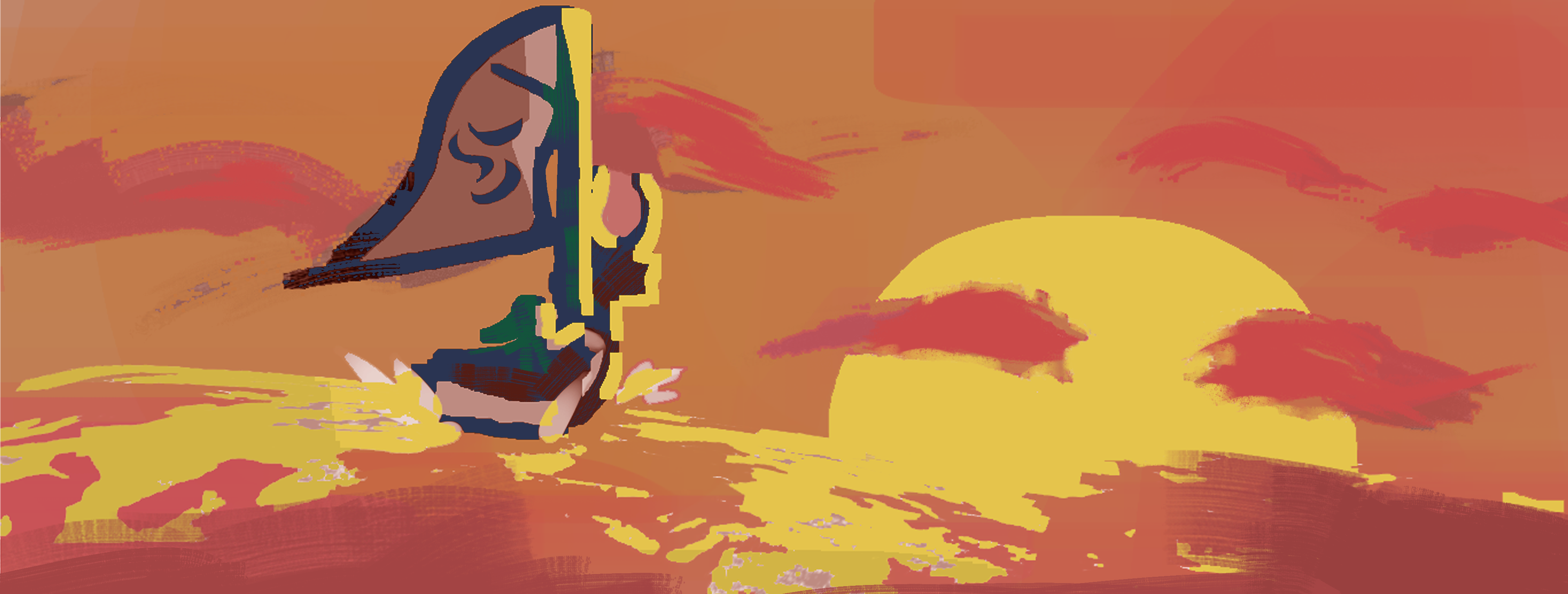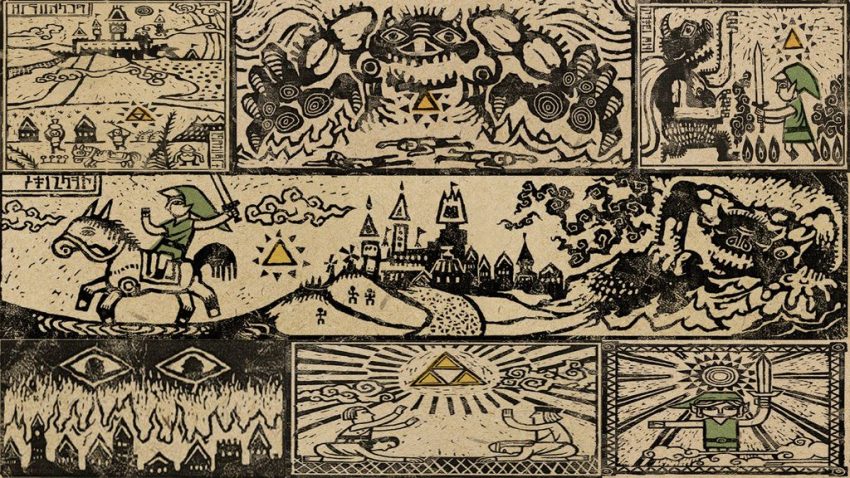Sail on to Brighter Futures: Looking Back at the Themes of The Wind Waker
Posted on August 27 2023 by Charles Xavier

Don’t judge a book by its cover.
Looking at the GameCube cover of The Wind Waker, it shows a cartoony Link sailing on an odd boat, with a wave swelling beneath it. The composition gives a sense of adventure, of excitement, and Link’s expression creates a feeling of cheerfulness. The actual game maintains those cartoony graphics and is full of saturated colors. Perhaps blinded by these appearances back in 2003, journalists and gamers alike decided that The Wind Waker “was too childish” for their liking.
Two decades later, the game is generally regarded among the best Zelda games ever made. I used to wonder if that’s due to a generational shift, or due to the older generation changing their minds. Regardless, it’s a turn of events that I was happy to see, because I’ve loved the game since Day One.
I got a copy of The Wind Waker on my eighth birthday. I suppose I was part of what those journalists deemed the “target audience” back in 2003. Looking back, I’m grateful for it. At that time, I had no access to the internet, and I didn’t read game reviews. I’m sure it was probably the same for a lot of people who were my age at the time. Our generation got to sail into The Wind Waker in the most pure way because we had no idealized notion of what a Zelda game “should be.” And despite us probably not being critical enough of the media we consumed at the time, I feel it doesn’t matter in the end. Most of us have probably gone back to The Wind Waker to find our love of it was not swayed under a critical lens, validating our childhood feelings of the game.
That said, after talking to many fans in my age range, we typically all agree: The Wind Waker has one of the best main quest stories in the series. For me, its theme, summarized, is one of courage to push on even among uncertainty to forge a better future.

“What became of that kingdom? None remain who know”
It’s rare for a prologue to a game to ever capture my complete interest and to successfully establish a mood right away. The Wind Waker managed it. It tells a tale of a bygone era where Ganon attacked the kingdom of Hyrule, and the Hero of Time vanquished him. After a period of peace, tragedy struck when the seal on Ganon broke. Unlike before, the Hero did not reappear to stop him, so the people could do nothing but leave their fate up to the gods. However, as the tale tells, the fate of Hyrule became a mystery.
Then the game really starts. Once I got control of Link, I looked out towards a vast ocean with a feeling of sadness. “Hyrule is out there somewhere, right?” I questioned, and I hoped, but I didn’t yet know.
Soon, Link’s adventure is spearheaded out to The Great Sea when his younger sister gets swept away by a large bird. Can Link save her? He’s just a kid, but he has to try! He learns she is at the Forsaken Fortress, hitches a ride with Tetra and her pirate crew, infiltrates the fortress with their help, but gets caught. The bird tosses his unconscious body out to sea. By a stroke of luck, he gets saved by the King of Red Lions.
What begins as simply a quest to save a relative swiftly turns into a battle for the fate of the entire world. But Link just failed to save his sister. How can he save the whole world? He has to push on and hope to find a way.
The journey becomes sailing to different Islands to gather Goddess Pearls. Once collected, he must complete the Tower of the Gods to find the key to defeating Ganondorf.
Through that, I got an answer regarding Hyrule’s fate – the people gathered on the mountaintops as the gods flooded the kingdom to stop Ganon. Hyrule still exists, but it’s lost beneath the waves. That led to a new thought for me: “Perhaps Hyrule can be restored?”
The King of Hyrule wants this, and it sounds like a good plan. Afterall, isn’t that the entire point of most Zelda games? Restoring a collapsed Hyrule to peace and prosperity? Surely this game will end the same as all other games before. Ganondorf will be killed or sealed, and Hyrule can return to normal!
I continued playing to find out. Armed with the Master Sword, Link returns to the Forsaken Fortress, this time managing to save his sister and all the other prisoners. However, when he attempts to face Ganondorf, he experiences failure yet again. The Master Sword has lost its power to repel evil; it must be restored if Ganondorf is to be defeated. Ganondorf discovers here that Tetra has the Triforce of Wisdom; suddenly there is a possibility our two heroes may not make it out of here alive. Luckily, with the the aid of Valoo and the Rito, Link and Tetra escape Ganondorf’s clutches. Can Link manage to fix the sword? He has to continue sailing to new and familiar islands with hope that he can.
With help from reawakened sages, he restores the Master Sword to full strength. Then he gathers the shards of the Triforce of Courage to return to the kingdom beneath the waves to face Ganondorf. The stakes become raised when Link discovers Ganondorf has kidnapped Tetra! Will Link be able to stop Ganondorf after so much failure before? He has to tread on and hope he can.

“That land will not be Hyrule. It will be YOUR land”
In the final battle, Ganondorf assembles the Triforce with intent to wish for the restoration of Hyrule. He wants it restored so the land can be his to rule. The very thing that should normally be fought for is the exact thing the antagonist wants to use the Triforce for. In an unexpected twist, the King of Hyrule instead uses the Triforce to wish for ancient Hyrule to be washed away, and for Ganondorf to drown with it.
After a long battle, Link stabs the Master Sword through Ganondorf’s forehead (pretty brutal, by the way), causing Ganon to turn to stone. Link and Tetra then get swept away as the kingdom is flooded for good.
The only future is to make a new kingdom. Thus, the game ends with much the same feelings it began with, and the feelings it illustrates throughout: somberness, uncertainty, but hope. Hyrule is no more, the only path left is to move forward.
To this day, the ending still shocks me. The stylization of the graphics and the color pallete do create a sort of dreamlike vibe like nothing can really go wrong. Yet things go back to the prologue, which establishes a totally different mood that is more representative of what the story actually holds. Again, don’t judge a book by its cover.
That’s what makes The Wind Waker‘s story stand out; it completely subverts expectation, but also it’s a story rooted in feelings we deal with a lot in reality. Other Zelda games touch on various feelings and themes too, except they are mostly situational. The Wind Waker‘s theme captures something that we can feel almost on the daily: the uncertainty but limitless potential of what the future could hold.
None of us know what the future may bring. We can feel nostalgia of the parts of our life behind us, and in that there can be a feeling of somberness. While looking forward, we’re like Link and Tetra ready to set sail from Outset in search of that new kingdom. We don’t know for sure if we’ll get there, but we have to take a deep breath, hope for the best, and sail on to brighter futures.
Have you ever recognized this theme in The Wind Waker? What are some goals you are currently working towards? Let us know in the comments below!
Featured Image by yours truly @VehkSketch

Charles is a Senior Editor at Zelda Dungeon. He is a Visual Development artist focused on enviroments and pitch paintings. Check out his Instagram and Twitter to see his latest artworks, a lot of which is Zelda fan art! His favorite candy is Skittles – he feels the world should know this.



